In The Times: “Paul Theroux’s Mexican Journey” (Malawi)
In his 70s, the writer embarks on one of the great adventures of a traveling life, a solo road trip from Reynosa to Chiapas and back.
•
Paul Theroux’s Mexican Journey
By Paul Theroux (Malawi 1963–65)
Photographs by Cesar Rodriguez
New York Times
Sept. 23, 2019
In the casual opinion of most Americans, I am an old man, and therefore of little account, past my best, fading in a pathetic diminuendo while flashing his AARP card, a gringo in his degringolade. Naturally, I am insulted by this, but out of pride I don’t let my indignation show. My work is my reply, my travel is my defiance.
Sometimes, a single person, met casually on a journey, can be a powerful inspiration. I happened to be in Nogales, Mexico, to talk to migrants — and on that visit I saw a middle-aged woman praying before her meal in a shelter. She was Zapotec, from a mountain village in Oaxaca state, and had left her three young children with her mother, intending to enter the United States and (so she said) become a menial in a hotel somewhere and send money back to her family who were living in poverty. But she had become lost in the desert, and spotted by the Border Patrol, seized and roughed up and dumped in Nogales. The image of her praying did not leave my mind and it strengthened my resolve to take a trip throughout Mexico, but concentrating on Oaxaca, one of the poorest states; and on my trip whenever I felt obstructed or low, I thought of this valiant woman, and moved on.
I studied the map. I had no status except my age, but in a country where the old are respected, that was enough — more than enough.
So I took an improvisational road trip along the border and the length of Mexico, from the frontier to Chiapas, with the kind of excitement I felt as a young man. One of the greatest adventures of my traveling life, this trip on the plain of snakes (as I thought of it) was enlightening and pleasurable, Mexico’s splendors vastly outweighing its miseries, and, though I had been warned repeatedly beforehand, I did not die.
I had begun my trip in a mood of dejection and self-pity, feeling shunned, overlooked, ignored, rejected — easily identifying with migrants and Mexicans, who knew the feeling of being despised. I’d hoped the trip would be salutary, a cure of my sour mood, and so it proved. I was uplifted, smiling when I set off for home, my hand on my heart, promising to return. In my time in Mexico I’d made many friends with Mexican writers, spoken at a number of literary and political events, and found a Mexican publisher. One of the greatest thrills in travel is to know the satisfaction of arrival, and to find oneself among friends.
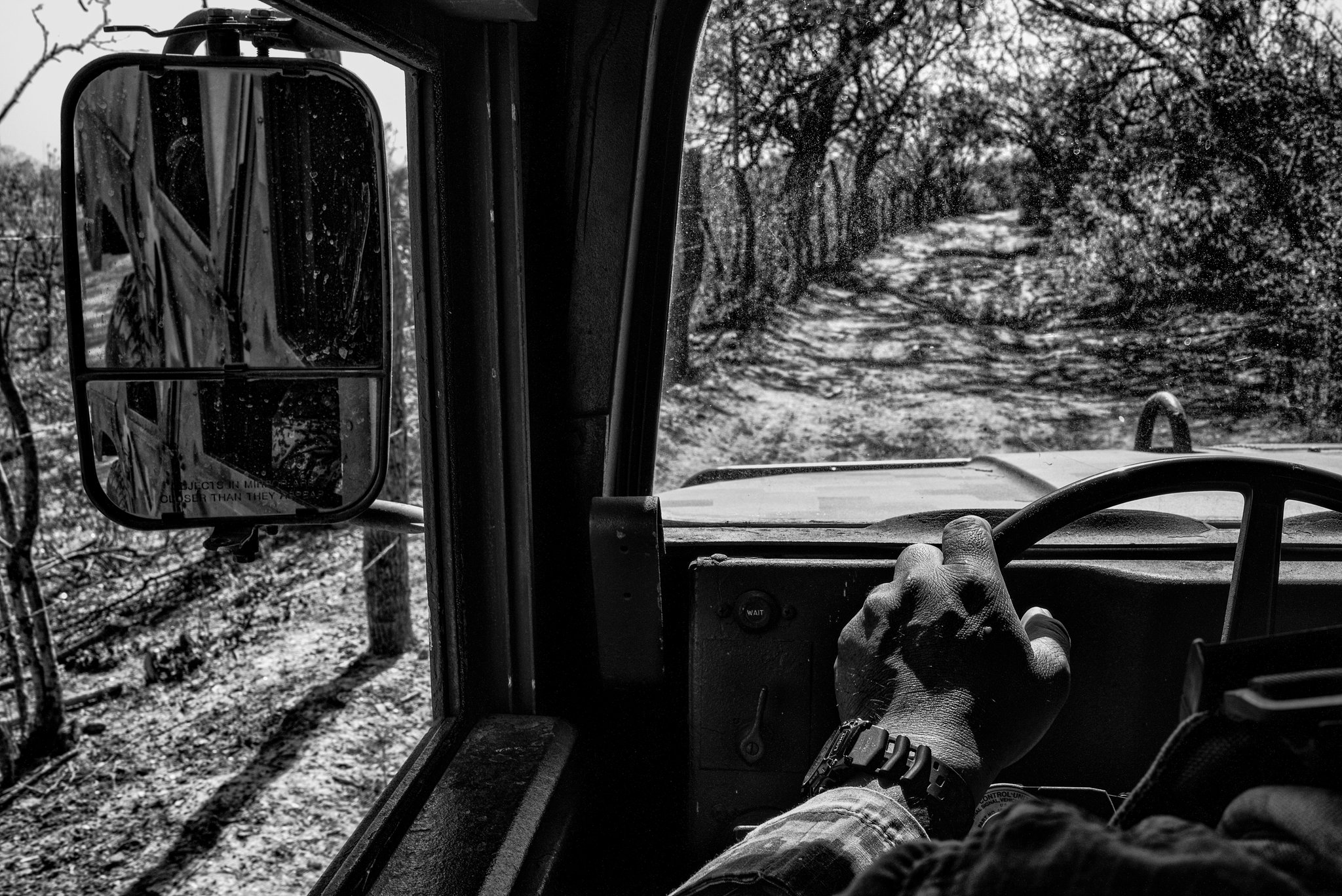
A Mexican Army patrol along the border between Mexico and the United States in territory where the drug cartels dominate.
Now, making my way home to the United States,I took the migrant route all the way north, except instead of riding on top of a rattling boxcar of the train known as the Beast, or in a clanking bus or a narco van, I was speeding in my own car, leaving San Cristóbal de las Casas, in the southern state of Chiapas. “I’m going to miss San Cristóbal,” a man says in Charles Portis’s novel “Gringos.” “This place is cool and pleasant the year round, a fat man’s dream.”
The autopista was closed — I was waved back by a policeman — so I took the old winding road on the eastern slopes of the Sierra Madre del Sur, the narrow track that had been cleared by the Dominican friars from Oaxaca in their pursuit of converts, and the conquistadors in search of gold.
The road hugged the high slopes, sometimes obscured in cloud, in sunny places allowing glimpses into lush valleys below, so deep they seemed like abysses. For many years this slow track was the main road in and out of San Cristóbal, and was still known as the Carretera Internacional, because it leads to Guatemala and beyond; but the new, straighter autopista superseded it in 2006. The only town on this old winding road was Navenchauc, a community of low square houses, most of them made of rough unpainted cement blocks, lining mongrel-haunted lanes.
From the cold 6,000-foot heights of the Sierra Madre de Chiapas, the road twisted down 4,000 feet through the forest to the heat of Tuxtla Gutiérrez, then dropped 2,000 more on a straight road to the hot gusts of wind and dense humidity of the sea-level tropics, crossing from Chiapas into the state of Oaxaca. There, at a roadblock, a policeman in a sweat-stained shirt, clawing the air, directed me off the road. He was an older man, weary-looking and yawning, scowling at my Massachusetts license plate, his manner, in the Mexican policeman way, peevish.
“Is this your car?”
“Yes. I have papers — my Vehicle Importation Permit, my insurance, my license,” I said, and began fossicking in the plump folders in my briefcase.
Something in my manner, perhaps my reciting my documentation, my fussing, wearied him further. “You can go,” he said.
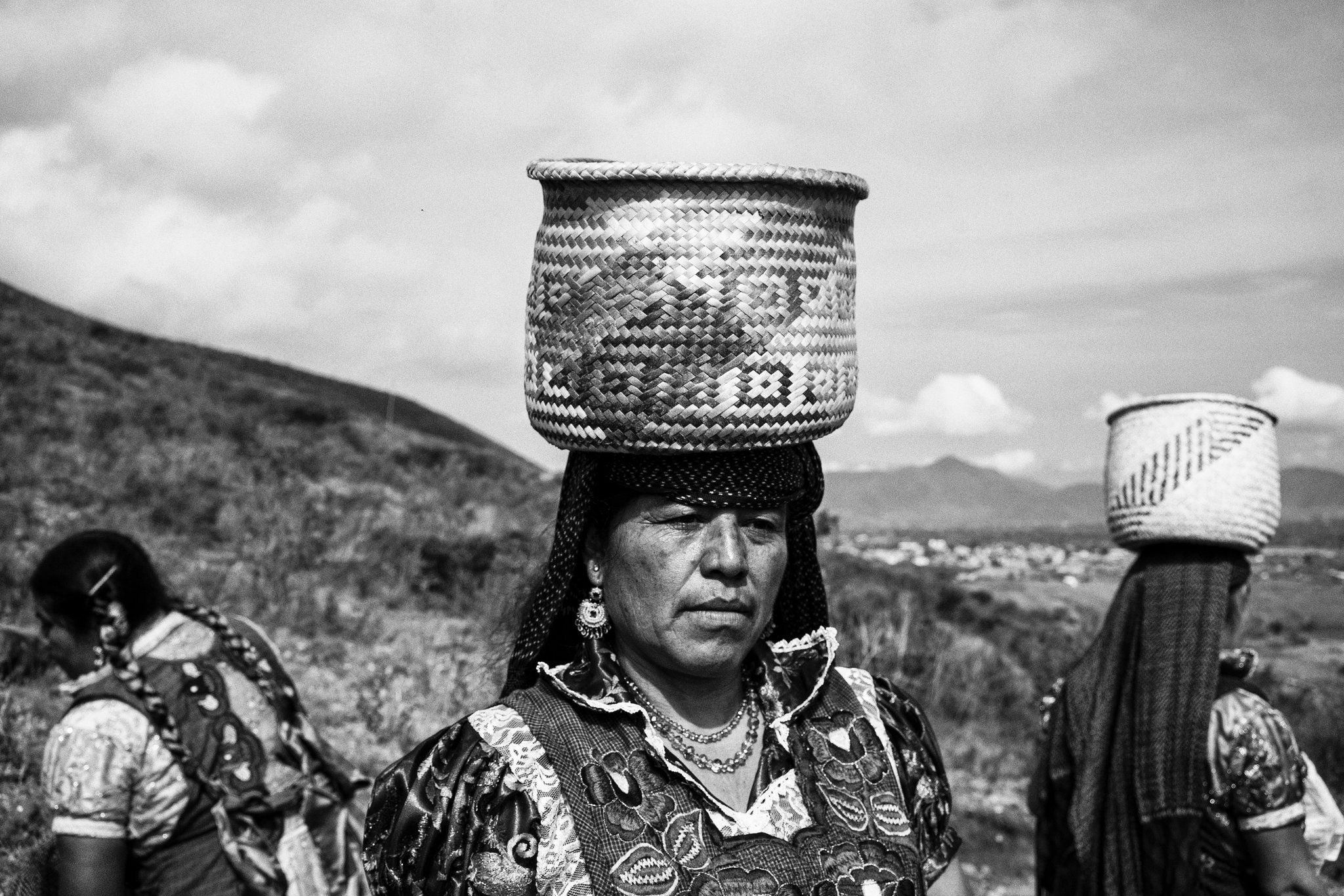
At center, Macrina Mateo Martínez, a Zapotec woman, with a basket full of red clay.
Heading for Oaxaca
I bypassed Juchitán, circumvented Tehuantepec and entered the hills, climbing back into the sierra, sun-dried, dust-blown and arid — the biscuit-brown, baked-looking mountains of upland Oaxaca.
Around midafternoon I stopped to eat in La Reforma, a small town aslant on the mountainside, scattered on both sides of the road, one building signposted Restaurante Rosa. It was a good-sized family house, the parlor furnished with two dining tables. No other diners today.
“Welcome.” Three women greeted me, three generations: an old woman at a stove, her daughter busying herself sifting maize flour, the gawky granddaughter sprawled on a wooden chair — her long legs stretched out, her feet on the arm of another chair.
“Where are you going?” the old woman asked. We spoke in Spanish.
“The border,” I said. “To the United States.”
“Take me with you!” she cried out, and gripped my arm.
“What will you do there?”
“I can cook. I can clean your house. I can look after you. Take me with you — take me away from here. I don’t care where you come from. I want to go there.” She let go of my arm to stand aside and put on a pleading face that was also intentionally clownish. “Please come back for me.”
Her daughter by now had made me the quesadilla I’d asked for, and brought it on a plate with a cup of black coffee. The granddaughter was laughing softly, wagging her bare brown feet. She was languid and beautiful, with a long, sallow Modigliani face, sharp eyes and slender fingers.
“How old are you?” I asked, to change the subject.
“Twelve.”
Provoked by my question, the old woman’s daughter — the girl’s mother — approached me and sized me up. “How old are you, señor?” “Adivina.” Take a guess.
She studied me, she did not speak, she cocked her head, pursed her lips, and pressed a finger to her cheek, in actressy reflection, liking the suspense she was creating.
“Seventy-six,” she said. Tilting her head back, looking haughty, she was triumphant.
“But I’m a cabrón,” I said, thumping my chest.
They shrieked, because the word had a belittling meaning here, not “dude,” as I had meant, but “dickhead.”
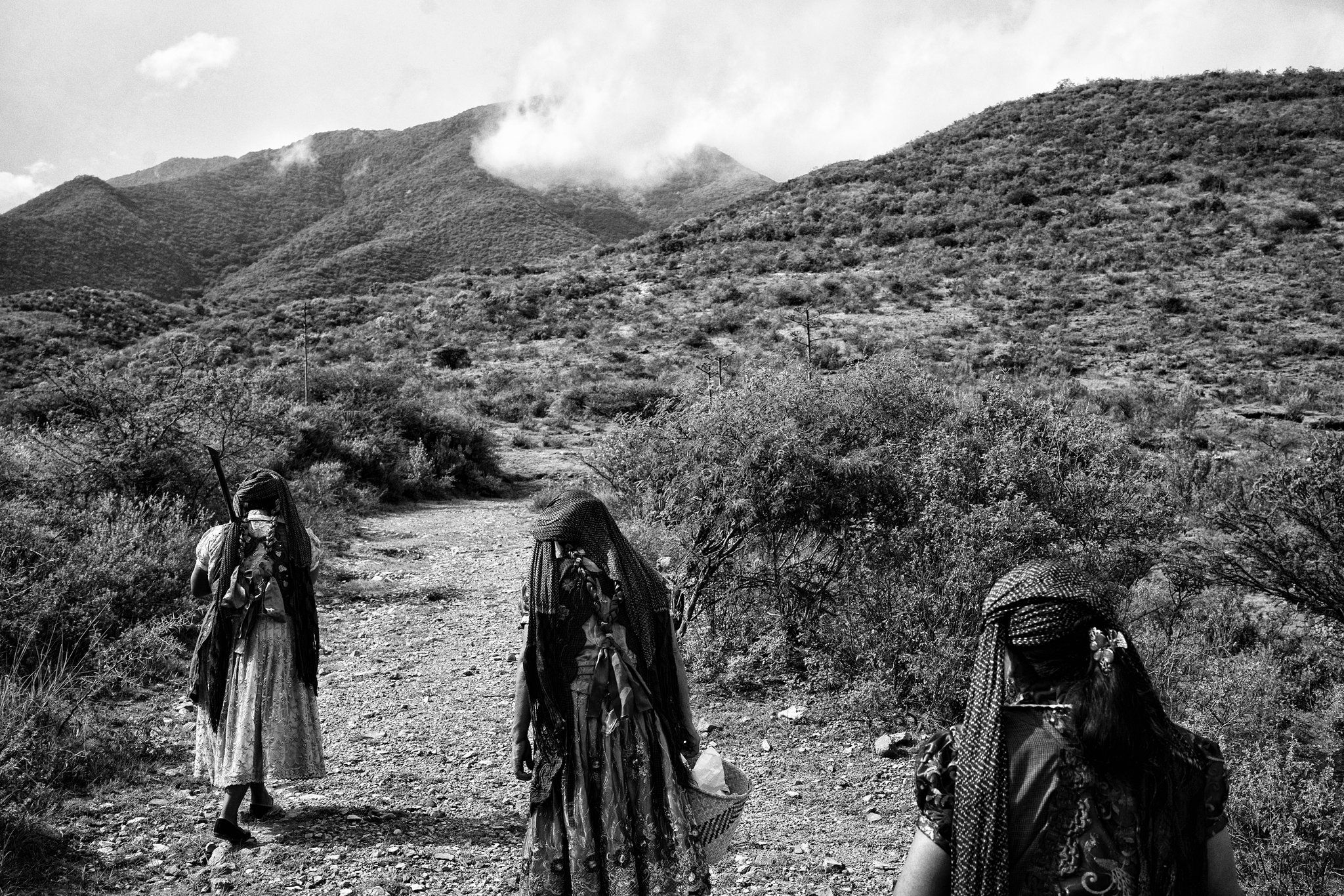
From left, Alberta Mateo Sánchez, Amalia Cruz Martínez and Macrina Mateo Martínez, in the mountains of San Marcos Tlapazona looking for red clay.
Into the mountains
I spent two days in San Jerónimo Tlacochahuaya, outside Oaxaca city, and then I left at sunup and drove down the dirt road past the agave and garlic fields onto the main road and beyond Oaxaca and Etla. There was no blockade at siege-prone Nochixtlán, where the teachers’ union had regularly been holding protests and where the footbridge still bore the slogan of the demonstration I had happened on earlier, “Justice and Rights for All People,” and the rusted, burned-out bus still lay where I had last seen it.
The deep ravines of the Mixteca Alta, farther on, were the most dramatic, the emptiest, I’d seen in Mexico. High peaks rose to the southwest, and deep down, the river looked black from this height, and the valley lay in shadow. At a steep part of the road, I saw a small boy, no more than 9 or 10, treading close to the curb, balancing a bundle of slender, eight-foot bamboo poles on his shoulder — no houses or side roads anywhere, the small, solitary figure with his awkward burden.
The first time I’d driven near here, I’d had to detour into the countryside, slewing and skidding on goopy rain-sodden roads in slurries of mud, through a thunderstorm with three hitchhikers. But today I was speeding, going faster when the road flattened nearer Puebla. Next to the highway, always the signs of old Mexico, goatherds shuffled in the tall grass beyond the guardrails, the goats kicking up dust.
In the dark back streets of Matehuala, looking for a place to stay, I remembered the friendly motel, Las Palmas, where I’d slept on the way south: behind a strong fence, secure for my car, with clean rooms and local food.
“You are coming from?” the clerk at the reception desk asked. She was tall, in a tailored suit that was perhaps her uniform.
I told her Oaxaca.
“Did you eat grasshoppers?”
“Lots of them. Ants, too. Very tasty.”
She pursed her lips. “We have better food here.”
Cabuches were in season, the buds of the biznaga (or barrel) cactus, like baby Brussels sprouts. I had a plate of them, and the other Matehuala specialty again, cabrito al horno, baby goat baked with the skin on, tender and slimy.
The waiter, Hilário, asked me whether I was going north. I said yes.
“Don’t go through Reynosa. It’s bad there.”
“I was planning to go that way.”
“No.” He was firm. “My home is in Monterrey. I know Reynosa is dangerous right now. Especially this week.”
“What about Ciudad Alemán?”
“Better, I think.”
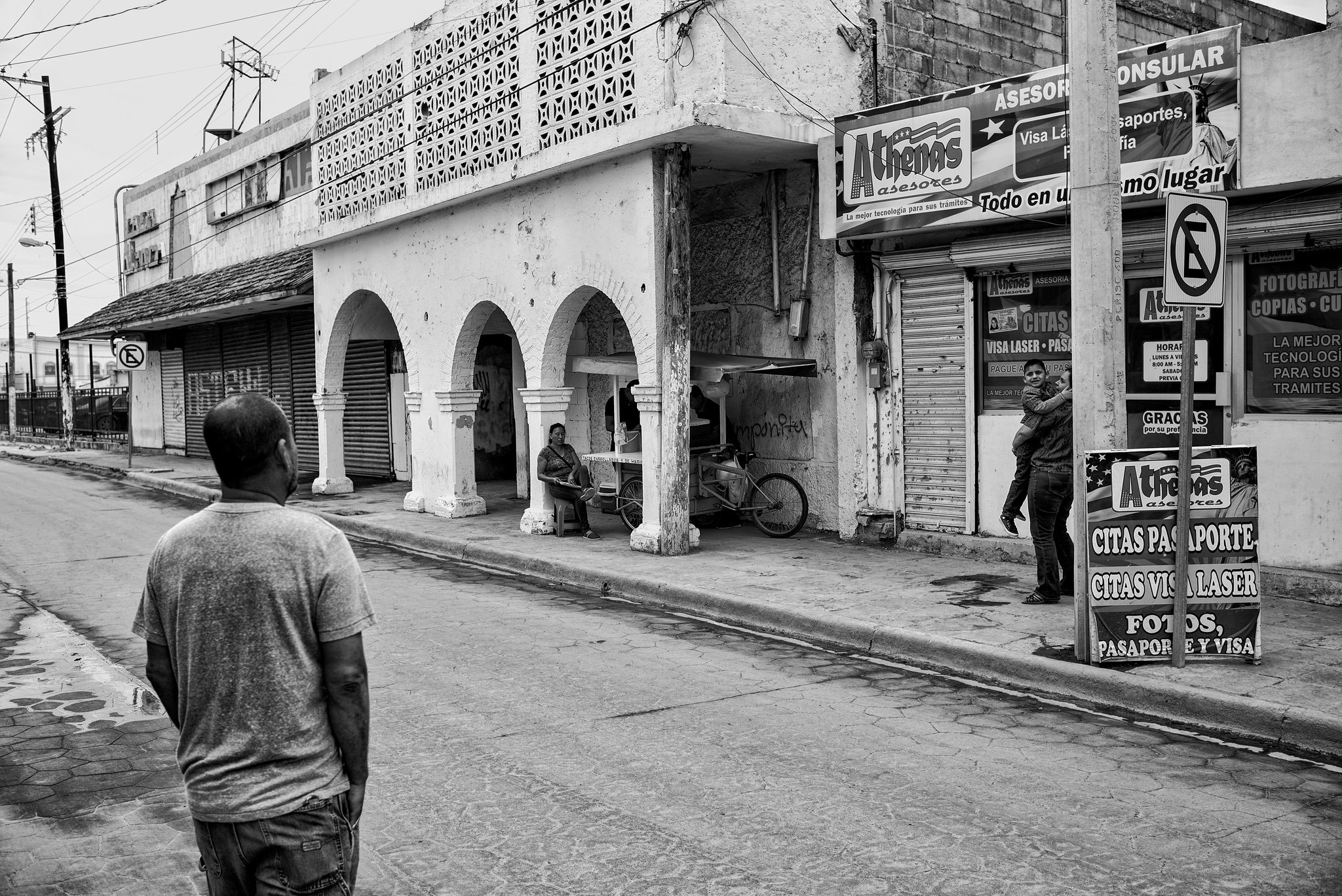
The almost empty streets of the border city of Reynosa, where the drug cartels control much of the city.
Driving through the small settlements in the heat and glare the next day — every building and every road sign, even the shepherds and the women and children carrying bundles, all coated with a fine film of dust — a feeling of melancholy descended on me. I guessed this was because of the self I remembered from being here long before, the dejected man who had no idea where he was going. But I was a different person now, because I knew where I had been. Instead of being purified by suffering — sometimes the consequence of a travel ordeal — I had made friends on the road and that had lifted my spirits.
I had marveled at this desert landscape on my trip south; it still bewitched me with its stark beauty and unexpected wildness. Taking a side route away from Saltillo, I found myself circling the steep, gravelly brown mountains that serve as the dramatic backdrop to Monterrey, so simple and shapely, with sharp peaks and knifelike ridgelines, such an amazing eruption of sierra, yet so close to the flat land of Texas just north.
From this simplicity and rugged beauty I saw the density of Monterrey in its populous valley, the confusion of roads, the sun beating down on the mass of white, flat-topped houses that looked hot and Moroccan. I headed east and then north along the edge of Monterrey, through industrial suburbs and fenced compounds of bleak tenements, east to Cadereyta Jiménez — notorious for gangs — to Cerralvo (a restaurant, a gas pump), following signs to Ciudad Mier.
The road north was flat and straight through the fields of mesquite and tall grass, sparsely inhabited, only a few roadside villages and very few other cars.
Fiddling with the radio in my car, I heard music from a Monterrey station, classical music I had not heard anywhere else in Mexico, and happened upon a lovely piece (violin, cello, piano) I’d heard before, but couldn’t name. This sweet soundtrack soothed me and sped me onward, past the tall grass and twisted trees.
Long before, in Ciudad Alemán, on my traverse of the border, a shopkeeper had said to me, “Don’t go outside town. Twenty miles away are the ranchitos, and the mafia.”
I was traveling in the area of the ranchitos and the mafia now. It was around here, so the shopkeeper had suggested, the cartels were located. Looking closely at passing buildings, I saw no people, just broken windows, empty stores, abandoned houses and collapsed fences, suggesting fear and chaos.
“And that was the Notturno in E-flat Major by Franz Schubert,” the woman on the Monterrey radio station said as the music ended.
There were not many big houses — perhaps three in the hundred miles from Monterrey — but each fancy villa seemed to represent drug money.
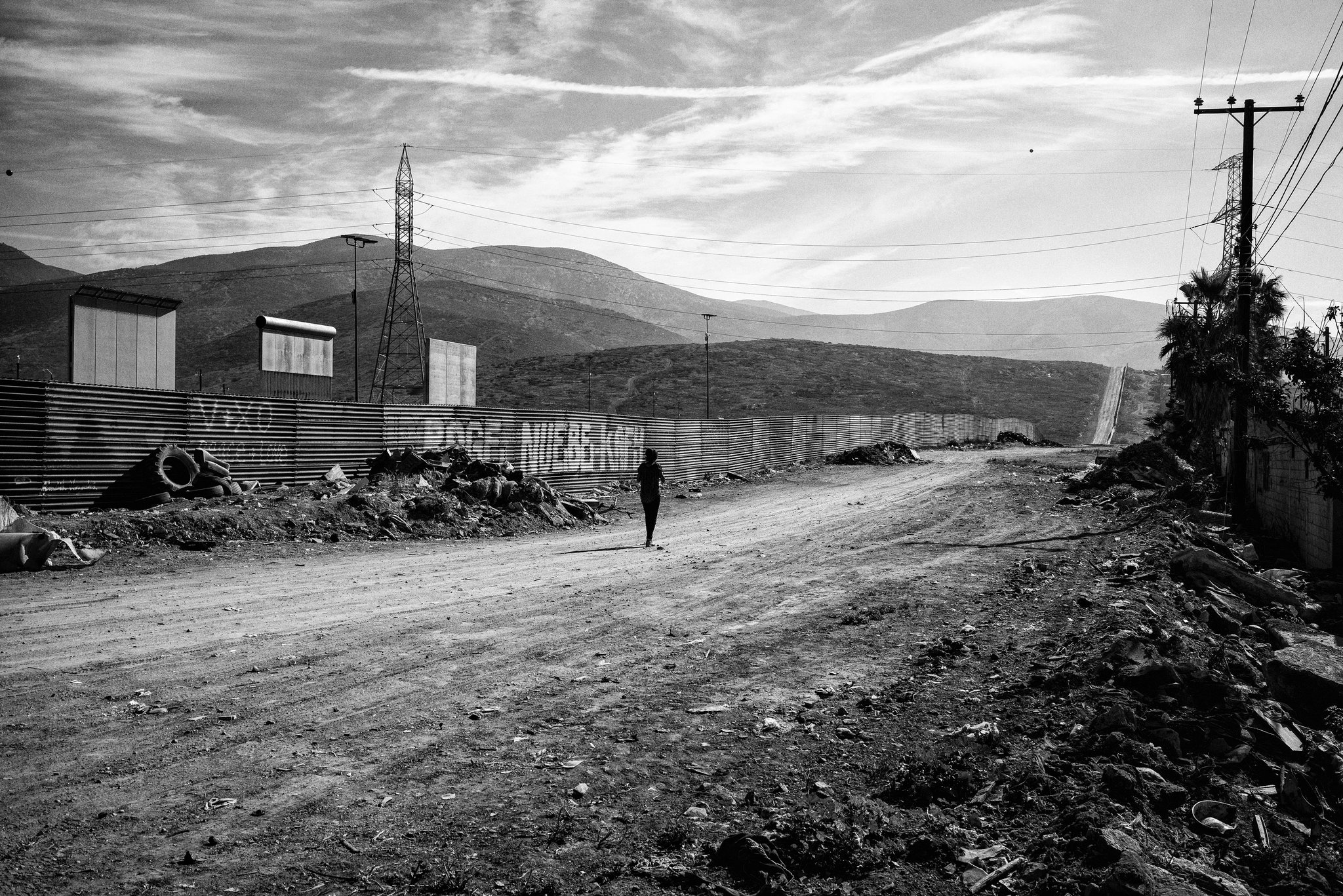
A woman walks along the border in Tijuana.
At a road junction near the town of Mier I stopped to let a truck pass and was surrounded by eight youths pressing their faces against my windows.
“What’s up?”
Shaking a tin can at me, one boy said, “We’re collecting money for the Queen of the Day.”
I put some coins in the can and said, “Where’s the queen?”
A girl pushed past the boys and smiled at me. She wore a black, lacy see-through blouse, tightfitting shorts, and — on this hot back street in Nuevo León — white patent-leather high heels. She placed a hand on each cheek, tilted her head like a stage coquette and pouted moodily.
“I am the queen,” she said. Her fingernails were sparkly against her cheeks.
I asked the boys, “Which of you have been to the United States?”
Two of them said they had been across, to the Texas town of Roma, about six miles away. The torment of Ciudad Mier, suffering in its dust and neglect, was that the fabulous kingdom of money was just down the street and over the narrow river.
I was exhilarated as I set off, but a blocked road and a detour sign sent me into a deserted village, where I began to worry — a dirt road, no signs, ruined buildings, like driving into the sort of entrapment I’d been warned about. I kept on, fretting, until I saw a paved road in the distance, and took it. A mile or so farther on, the curio shops, the taqueria where I’d once had a meal, the shop where I’d seen a pear-shaped, orange-haired piñata in the shape of Donald Trump, the plaza where I’d had a shoeshine.
Although Texas was just across the river, no gringos circulated here. I was hungry, so I went back to the taqueria. Then I bought an ice cream. I sat in the plaza and had my shoes shined, savoring the delay.
But when I told the shoeshine man, Héctor, the route I had come, he said, “You’re very lucky.”
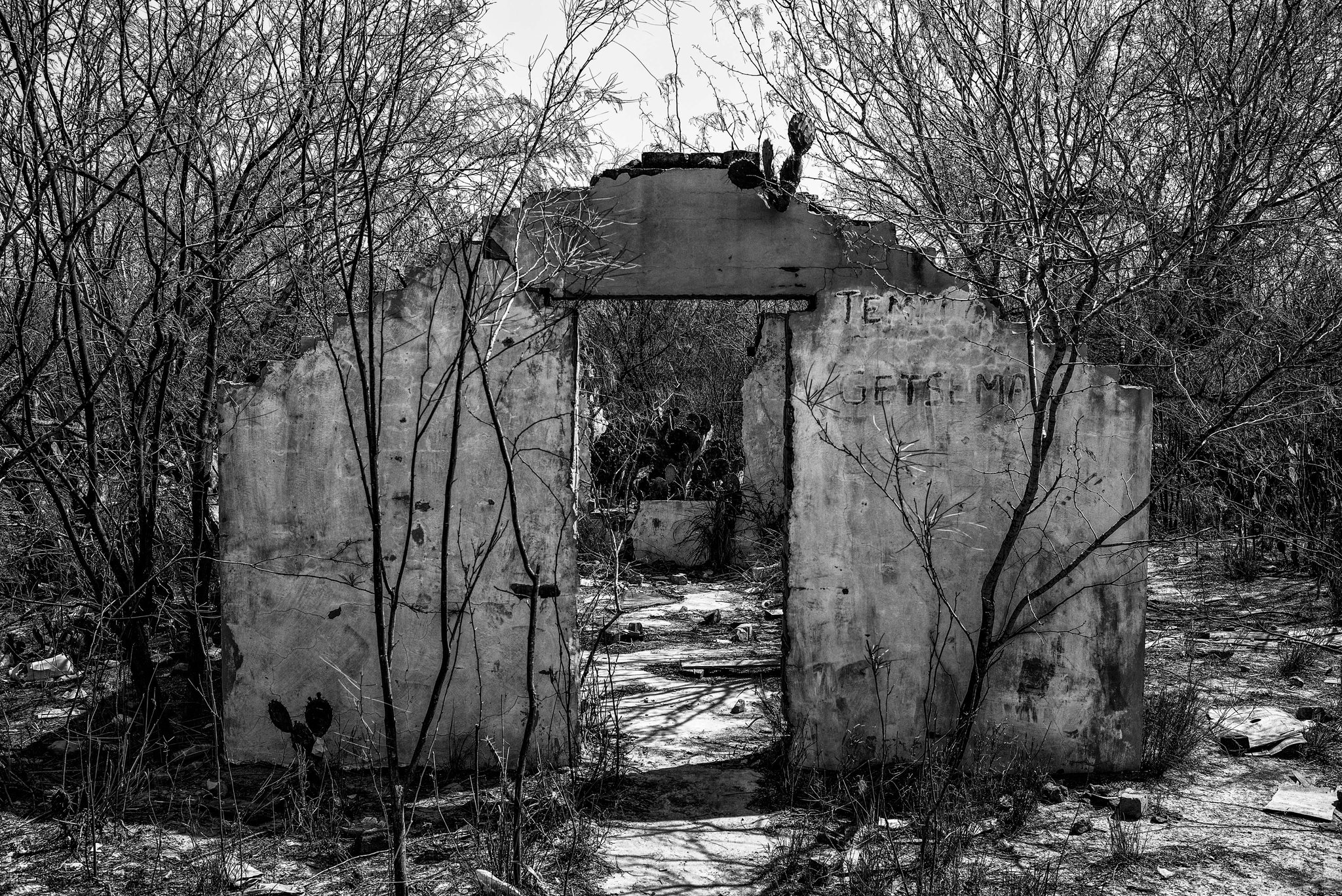
An abandoned church on the outskirts of Reynosa.
His last mordida
I didn’t think much about that remark. Without a hitch I crossed the international bridge to Roma. A boy on a Jet Ski skidded in circles on the Rio Grande below the bridge. I had taken a simple detour from Monterrey, as Hilário had suggested in Matehuala, a safe back road through the eastern suburbs of Monterrey and Cadereyta Jiménez.
But “You’re very lucky” preyed on my mind. And later I researched the recent history of the area and found that Route 54 was strategic for human and drug smuggling, that this whole border state of Nuevo León had become a battlefield on which the Zetas and the Gulf cartel vied for dominance. Kidnappings and mayhem were common; in the manufacturing town of Cadereyta Jiménez (broom factory, oil refinery, workers’ tenements) five municipal employees were massacred in 2012, and in the same year, in San Juan, a town just 75 miles southwest of Roma, 49 bodies were discovered dumped on the federal highway I’d traveled, all of them decapitated and dismembered, all of them young men, and none of them (because of the butchery) easily identifiable.
Yes, I was lucky — incredibly so. Lucky in the people I met, lucky in the friends I made, lucky even in my mishaps, my always emerging unharmed, with a tale to tell. More than 50 years of this, ever the fortunate traveler.
I’d arrived safely in Roma, but I was not done. I needed to apply for a refund on my Vehicle Importation Permit, and renew my visa in case I wanted to reenter Mexico. So I drove along the Texas side of the border to McAllen and then crossed into Mexico again, to the customs office in a building just inside the Reynosa frontier.
“I can’t do any of your visa paperwork today,” the clerk said “I can give you a refund on your permit, but there’s a three-day waiting period for the visa.”
“I can’t come back in three days. I need it now.”
“This is the law.”
I pleaded a little, explaining the inconvenience.
“Maybe talk to that man.”
He indicated a man in black. I explained my dilemma. He too told me about the specified waiting period.
A stark government sign on the wall behind the man’s head cautioned me, in large black letters in two languages, “Any Attempt to Offer a Bribe or a tip to an Official is Forbidden, and Punishable by Law.”
“I realize it’s a problem,” I said, and explained that I needed it now.
He listened carefully, then beckoned me into his office, nearer the warning sign. He rifled through my papers. He looked me up and down, seeming to make a mental calculation.
“Yes. I can help you,” he said in a whisper. “But it will cost something.”
At such a moment the wary traveler thinks: Given the severe sign, and the willingness of the man, this must be a trap. I offer the bribe and then I am arrested for the crime of offering a bribe.
“Cuánto cuesta?” I mouthed.
Fumbling with a ballpoint pen and agitatedly clicking it, seeming with each click to adjust his calculation, he finally gripped it and wrote “180” on a small piece of paper. Just as quickly he crumpled the paper, pinched it small, and pocketed it.
“Pesos?”
He snorted a little, and “hoicked”: a Mexican negative. I turned away and covertly selected nine $20 bills from my wallet, folded and flattened them, and palmed them to him. He did not thank me. He clucked softly, a satisfying un-gumming of his sticky tongue, and made the money disappear. Then he prepared my documents and wished me a good journey.
•
Paul Theroux’s latest book, “On the Plain of Snakes: A Mexican Journey,” from which this is adapted, will be published by Houghton Mifflin Harcourt on Oct. 8.
This is a journey I’m eager to learn about! Looking forward to reading the book in October.
Geri Marr Burdman
RPCV (Bolivia 1962-1964)
One more good read from Paul Theroux!
Charlie Ipcar, RPCV (Ethiopia 1965-68)
I especially identified with Paul’s paragraph admitting he hit the big 7 0 with “My work is my reply, my traveling defiance.”
I’m glad he spent additional time in Oaxaca which is my favorite part of Mexico. I made my own trip through Mexico from Guatemala to the US and back with my young Guatemalan wife on our honeymoon, a story told in my “Yin & Yang of Travel” series, “Traveling with a Chapina” which can be found in both “Literary Travelers” and “Revue” magazines.
I plan to read and review Paul’s book for my “Million Mile Walker Review: What We’re Reading and Why” for the Arizona Authors Association newsletter–in my last column I reviewed “Mosquito Coast” and ” Figures in a Landscape” and can’t wait to read this one.
Paul is still good to go at 7 0!
Mark D. Walker, (Guatemala, 1971-73)
“Different Latitudes: My Life in the Peace Corps and Beyond”
Thanks, Paul, for yet another special travel book. From your long-ago housemate at Soche Hill, in then newly-independent Malawi. John Turnbull Lower Canoncito, New Mexico
YouTube has a recent Paul Theroux lecture about this new book (see The Country Just Over the Fence, Feb., 2019). His travels along the border and on to the southern portions of Mexico began in 2017 when he was 76. That’s ballsy: my longest trip in the last few months has been to the corner store and I’m ten years younger.
Paul Theroux never disappoints. He “knows where he’s been” and is uplifted by simple encounters with simple people … always and in all his travels. No worries, Paul. You might be in your prime!
Leita Kaldi Davis